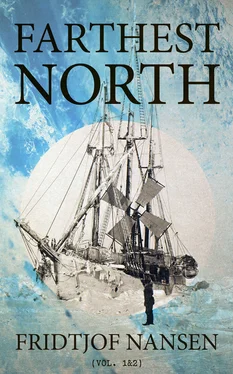“As an interesting fact in this connection, it may also be mentioned that the German botanist Grisebach has shown that the Greenland flora includes a series of Siberian vegetable forms that could scarcely have reached Greenland in any other way than by the help of such a current conveying the seeds.
“On the drift-ice in Denmark Strait (between Iceland and Greenland) I have made observations which tend to the conclusion that this ice too was of Siberian origin. For instance, I found quantities of mud on it, which seemed to be of Siberian origin, or might possibly have come from North American rivers. It is possible, however, to maintain that this mud originates in the glacier rivers that flow from under the ice in the north of Greenland, or in other unknown polar lands; so that this piece of evidence is of less importance than those already named.
“Putting all this together, we seem driven to the conclusion that a current flows at some point between the Pole and Franz Josef Land from the Siberian Arctic Sea to the east coast of Greenland .
“That such must be the case we may also infer in another way. If we regard, for instance, the polar current—that broad current which flows down from the unknown polar regions between Spitzbergen and Greenland—and consider what an enormous mass of water it carries along, it must seem self-evident that this cannot come from a circumscribed and small basin, but must needs be gathered from distant sources, the more so as the Polar Sea (so far as we know it) is remarkably shallow everywhere to the north of the European, Asiatic, and American coasts. The polar current is no doubt fed by that branch of the Gulf Stream which makes its way up the west side of Spitzbergen; but this small stream is far from being sufficient, and the main body of its water must be derived from farther northward.
“It is probable that the polar current stretches its suckers, as it were, to the coast of Siberia and Bering Strait, and draws its supplies from these distant regions. The water it carries off is replaced partly through the warm current before mentioned which makes its way through Bering Strait, and partly by that branch of the Gulf Stream which, passing by the north of Norway, bends eastward towards Novaya Zemlya, and of which a great portion unquestionably continues its course along the north coast of this island into the Siberian Arctic Sea. That a current coming from the south takes this direction—at all events, in some measure—appears probable from the well-known fact that in the northern hemisphere the rotation of the earth tends to compel a northward-flowing current, whether of water or of air, to assume an easterly course. The earth’s rotation may also cause a southward-flowing stream, like the polar current, to direct its course westward to the east coast of Greenland.
“But even if these currents flowing in the polar basin did not exist, I am still of opinion that in some other way a body of water must collect in it, sufficient to form a polar current. In the first place, there are the North European, the Siberian, and North American rivers debouching into the Arctic Sea, to supply this water. The fluvial basin of these rivers is very considerable, comprising a large portion of Northern Europe, almost the whole of Northern Asia or Siberia down to the Altai Mountains and Lake Baikal, together with the principal part of Alaska and British North America. All these added together form no unimportant portion of the earth, and the rainfall of these countries is enormous. It is not conceivable that the Arctic Sea of itself could contribute anything of importance to this rainfall; for, in the first place, it is for the most part covered with drift-ice, from which the evaporation is but trifling; and, in the next place, the comparatively low temperature in these regions prevents any considerable evaporation taking place even from open surfaces of water. The moisture that produces this rainfall must consequently in a great measure come from elsewhere, principally from the Atlantic and Pacific oceans, and the amount of water which thereby feeds the Arctic Sea must be very considerable. If we possessed sufficient knowledge of the rainfall in the different localities it might be exactly calculated. 5
“The importance of this augmentation appears even greater when we consider that the polar basin is comparatively small, and, as has been already remarked, very shallow; its greatest known depth being from 60 to 80 fathoms.
“But there is still another factor that must help to increase the quantity of water in the polar basin, and that is its own rainfall. Weyprecht has already pointed out the probability that the large influx of warm, moist atmosphere from the south, attracted by the constant low atmospheric pressure in the polar regions, must engender so large a rainfall as to augment considerably the amount of water in the Polar Sea. Moreover, the fact that the polar basin receives large supplies of fresh water is proved by the small amount of salt in the water of the polar current.
“From all these considerations it appears unquestionable that the sea around the Pole is fed with considerable quantities of water, partly fresh, as we have just seen, partly salt, as we indicated further back, proceeding from the different ocean currents. It thus becomes inevitable, according to the law of equilibrium, that these masses of water should seek such an outlet as we find in the Greenland polar current.
“Let us now inquire whether further reasons can be found to show why this current flows exactly in the given direction.
“If we examine the ocean soundings, we at once find a conclusive reason why the main outlet must lie between Spitzbergen and Greenland. The sea here, so far as we know it, is at all points very deep; there is, indeed, a channel of as much as 2500 fathoms depth; while south of Spitzbergen and Franz Josef Land it is remarkably shallow—not more than 160 fathoms. As has been stated, a current passes northward through Bering Strait and Smith Sound, and the sounds between the islands north of America, though here, indeed, there is a southward current, are far too small and narrow to form adequate outlets for the mass of water of which we are speaking. There is, therefore, no other assumption left than that this mass of water must find its outlet by the route actually followed by the polar current. The channel discovered by the Jeannette expedition between Wrangel Land and the New Siberian Islands may here be mentioned as a notable fact. It extended in a northerly direction, and was at some points more than 80 fathoms deep, while at the sides the soundings ran only to 40 or 50 fathoms. It is by no means impossible that this channel may be a continuation of the channel between Spitzbergen and Greenland, 6in which case it would certainly influence, if not actually determine, the direction of the main current.
“If we examine the conditions of wind and atmospheric pressure over the Polar Sea, as far as they are known, it would appear that they must tend to produce a current across the Pole in the direction indicated. From the Atlantic to the south of Spitzbergen and Franz Josef Land a belt of low atmospheric pressure (minimum belt) extends into the Siberian Arctic Sea. In accordance with well-known laws, the wind must have a preponderating direction from west to east on the south side of this belt, and this would promote an eastward-flowing current along the north coast of Siberia, such as has been found to exist there. 7The winds on the north side of the minimum belt must, however, blow mainly in a direction from east to west, and will consequently produce a westerly current, passing across the Pole towards the Greenland Sea, exactly as we have seen to be the case.
“It thus appears that, from whatever side we consider this question, even apart from the specially cogent evidences above cited, we cannot escape the conclusion that a current passes across or very near to the Pole into the sea between Greenland and Spitzbergen.
Читать дальше












